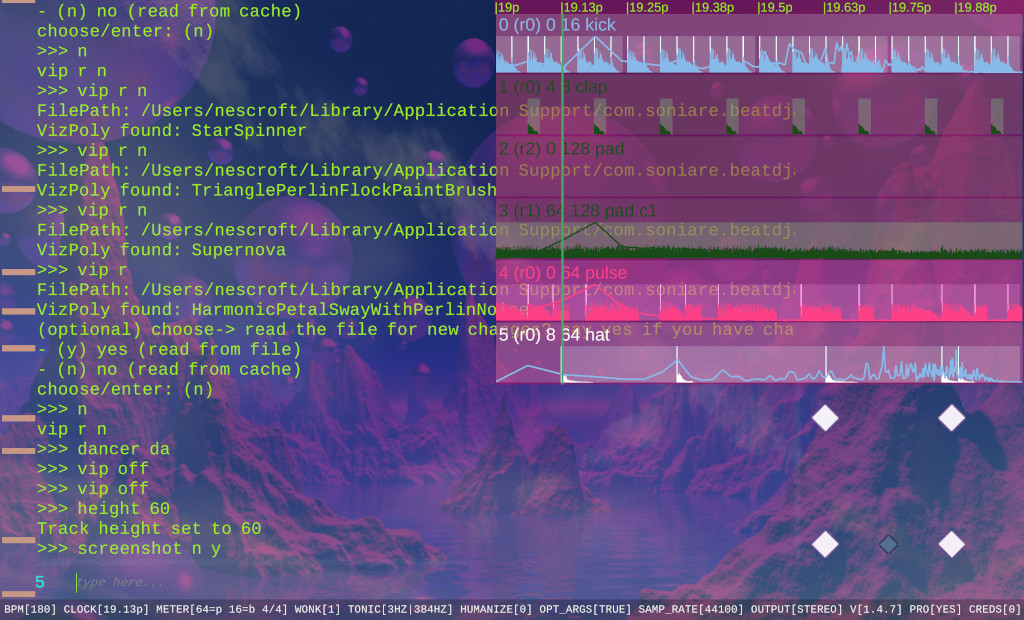- Published on
From Passive Generation to Active Performance: Why Live Coding Beats AI Music Creation
- Authors

- Name
- Nes Croft
- @nescroft
From Passive Generation to Active Performance: Why Live Coding Beats AI Music Creation
 Beat DJ Screenshot
Beat DJ ScreenshotAI music generators like Udio and Suno have captured attention for their ability to create polished tracks from simple text prompts. Type "upbeat jazz with saxophone solos" and receive a finished song in minutes. It's impressive technology, but there's a fundamental problem: these tools turn you into a music consumer, not a music creator. You're essentially commissioning an AI to make music for you, then waiting passively for the results.
This passive approach might feel productive in the moment, but it creates a creative dead end. You're not building musical skills, understanding composition, or developing your own voice. You're just getting better at writing prompts. Meanwhile, live coding approaches like Beat DJ offer something entirely different: active participation in music creation that builds real skills while delivering the immediate gratification of performance.
The Creative Limitations of Prompt-Based Generation
When you use Udio or Suno, your creative input is limited to text descriptions. You might specify "dark ambient techno with industrial drums" or "folk ballad with emotional vocals," but beyond that, you're at the mercy of the algorithm. If the AI misinterprets your prompt or generates something close-but-not-quite-right, your options are limited: regenerate with a slightly different prompt and hope for better results, or accept what you got.
This creates a frustrating creative bottleneck. The most important musical decisions, the ones that make a track uniquely yours, are happening inside a black box. You can't adjust the kick drum's punch mid-generation, tweak the bass line's rhythm, or add subtle filter sweeps that respond to the energy of the moment. You're stuck with broad, descriptive language trying to communicate nuanced musical ideas to a system that may or may not understand what you're after.
Compare this to Beat DJ's live coding approach. When you type kick dyn to adjust the dynamics of your kick drum, or bass mel to shift the bass melody, you're making direct, immediate changes to the music. Every command is a conscious creative decision, and you hear the results instantly. You're not describing what you want; you're crafting it in real-time.
Why the Creative Process Matters as Much as the Final Product
There's something deeply satisfying about the act of creation that AI generation simply can't provide. When you manually program a drum pattern, adjust filter cutoffs, or layer samples, you're engaged in the fundamental craft of music-making. Your hands are shaping sound, your decisions are building the track, and your musical intuition is developing with each choice.
This process of active creation builds what musicians call "feel" - an intuitive understanding of how musical elements work together. You learn why certain rhythmic patterns create tension, how frequency ranges interact, and what makes a transition feel smooth or jarring. These insights come from doing, not from prompting.
With AI generation, you miss this entirely. The algorithm handles all the musical decision-making, leaving you with no deeper understanding of why the result works or doesn't work. You might get a finished track, but you haven't grown as a musician. You're no more capable of creating music after using Suno for a year than when you started.
The Performance Revolution: From Studio to Stage
Perhaps most importantly, live coding systems like Beat DJ transform music creation from a studio process into a performance medium. When you're live coding, every session becomes a potential show. You can preview sounds in headphones before sending them to the audience, just like a DJ cueing tracks. You can respond to the room's energy, take requests, improvise, and create music that exists uniquely in that moment.
This performance aspect is what separates live coding from both traditional production and AI generation. With Udio or Suno, you create tracks in isolation, then play them back. With Beat DJ, the creation is the performance. The audience watches you build the music in real-time, seeing the code that creates the sounds, experiencing the creative process alongside you.
This immediacy changes everything about how you approach music. Instead of perfectionism and overthinking, you embrace spontaneity and flow state. Mistakes become happy accidents. Limitations become creative constraints that spark new ideas. The timeline is infinite, everything loops forever, letting you stay in the creative moment without constantly stopping and starting.
Building Real Musical Skills vs. Relying on Generation
The difference in skill development between AI generation and live coding is stark. With prompt-based tools, your primary skill becomes writing better descriptions. You might learn that "lo-fi" gets you certain textures, or "in the style of" helps guide the algorithm, but these are meta-skills about using the tool, not music skills.
Live coding, by contrast, develops core musical competencies. You learn about rhythm, harmony, sound design, arrangement, and mixing. Beat DJ's microtonal capabilities teach you about scales and tuning systems. Its command-line interface forces you to understand the relationship between different musical elements. Its real-time nature develops your ability to make quick creative decisions.
More importantly, these skills transfer. Understanding how to program interesting drum patterns helps you in any DAW. Learning about filter sweeps and effects teaches you fundamentals that apply across all electronic music production. Building a vocabulary of commands that manipulate sound gives you a deeper understanding of what makes music work.
The Satisfaction of Crafting vs. Consuming
There's a psychological dimension to this that goes beyond skill development. When you create something through direct manipulation, through conscious choices and careful craft, the result feels genuinely yours. You understand every element because you placed it there. You can explain every decision because you made it.
AI-generated music, no matter how impressive, carries a subtle sense of alienation. You might like the result, but you can't take full ownership of it. Someone asks how you got that particular sound, and your answer is essentially "I asked the AI nicely." The creative satisfaction is diminished because the creative work was outsourced.
This isn't to dismiss AI tools entirely. Beat DJ itself includes AI assistance, but in service of your creativity rather than replacing it. You might ask the AI to suggest a chord progression or generate visual elements, but the core musical creation remains in your hands. The AI helps you do what you want to do better, rather than doing it for you.
The Future Is Interactive, Not Automated
As AI music generation continues to improve, the fundamental tension between passive and active creation will only become more pronounced. Tools that make music for you might become incredibly sophisticated, but they'll always leave you in the passenger seat of your own creativity.
Live coding represents a different path forward: one where technology amplifies human creativity rather than replacing it. Where AI assists your creative process rather than handling it entirely. Where the act of creation remains engaging, educational, and deeply satisfying.
The choice isn't just between different tools; it's between different relationships with creativity itself. Do you want to be a music commissioner, describing what you'd like and hoping for good results? Or do you want to be a music creator, making conscious choices, building skills, and crafting sounds that are uniquely your own?
Beat DJ represents that second path: a conversation with your music through commands, real-time manipulation of sound, and the deep satisfaction that comes from active creation. It's the difference between having music made for you and making music yourself. And in that difference lies all the joy, growth, and authentic expression that makes music creation worthwhile in the first place.
